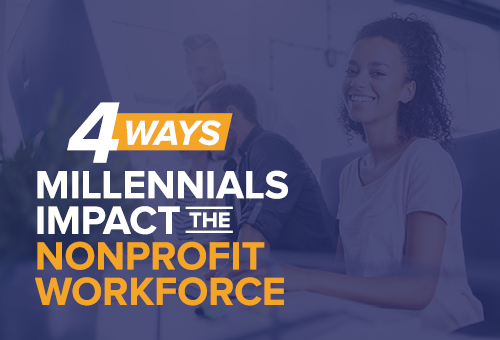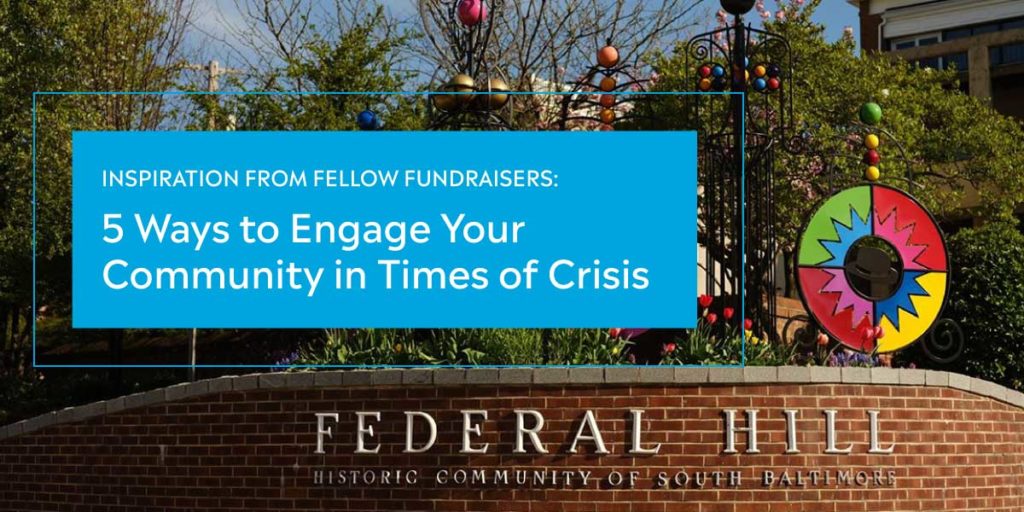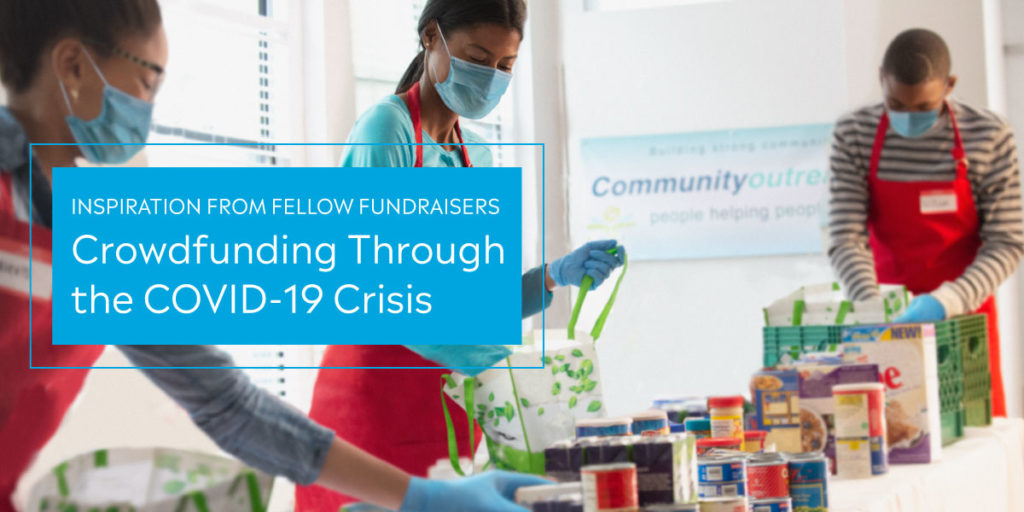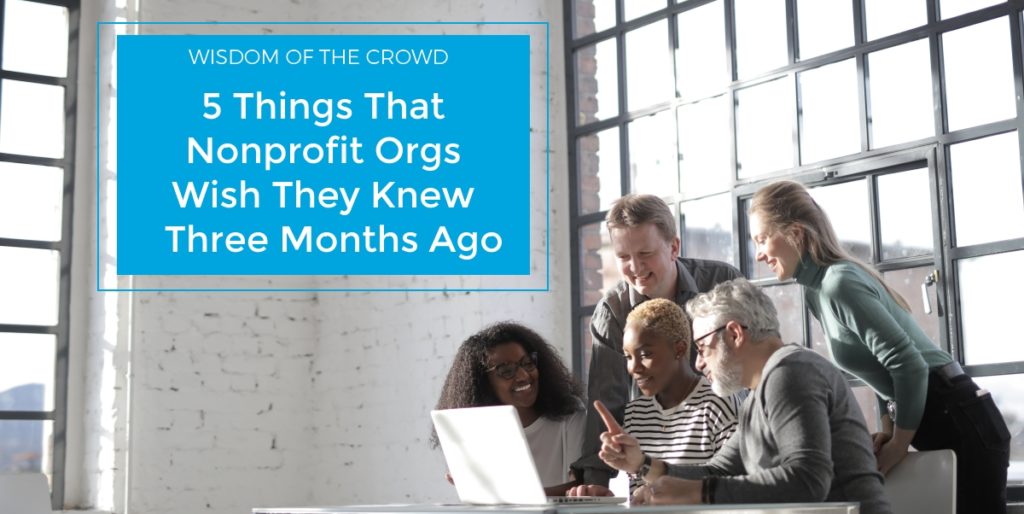Born from approximately 1981 to 1996, Millennials are primarily between ages 24 and 39. While popular media often refer to all young people as Millennials, it’s important to discern that this generation of individuals is now entering or fully integrated into the workforce.

The Millennial generation differs greatly from those who came before, Gen X and who came after, Gen Z. As your organization considers the role that young professionals can play in the staffing or contributions made to your organization, it’s important to understand the qualities and characteristics that make this generation unique.
When you understand the unique aspects of this group, you can make educated decisions about how to make your nonprofit an attractive place to work and volunteer, as well as motivate those who currently work for your mission.
That being said, here are the top four characteristics of the Millennial generation and how those characteristics impact their influence in the nonprofit workforce:
- Millennials engage more with causes and missions rather than institutions.
- They see contributions of time and action as significantly important.
- This generation is technologically apt and connected.
- Culture tends to be incredibly important to the millennial generation.
As you expand your team with new staff members and volunteers, be sure you take into account the motivations and characteristics of each individual. Remain transparent in your approach to get everyone involved and up to date with your strategy. This is attractive to both your Millennial team members and other generations.
Ready to dive a little deeper into the characteristics of Millennials and how your organization can make them feel welcome and productive? Let’s get started.
1. Millennials Engage With Causes Over Institutions
According to the Millennial Impact Report, the Millennial generation engages more and has allegiance to a mission or a cause rather than an organization itself. This means that this generation of volunteers and staff will feel dedicated to your mission, but not necessarily to your organization. If another organization has the same mission, they wouldn’t mind switching their allegiance.
This quality in Millennials is key to understanding what will attract them to work with and contribute to the organization, but also what will make them stay and work with you long-term.
If you’re working with many Millennials at your organization, make sure to:
- Write out a complete, descriptive, and detailed mission statement that will capture their attention. This is what draws them into working with you and clearly explains what your organization is working to accomplish.
- Include this mission statement on marketing documents and job descriptions. As you’re attracting younger generations to work with your organization, place your mission statement front and center for them to see.
- Center your strategic plan around the impact and philanthropic goals of the organization. Because Millennials are passionate about your cause, tying organizational actions to the impact they’ll have on the mission will engage and further motivate these individuals. Bloomerang’s strategic planning guide explains that your goal should never just be to “raise money.” Rather, you’re working to achieve a specific philanthropic initiative with a specific amount of money that you need to raise.
If your organization finds yourself in an uncertain or unsteady environment and want to make sure your team of staff members, specifically Millennial staff, stay focused on what’s important, you may consider switching to an organic strategic planning model.
This model is used to solidify your team’s understanding of your philanthropic mission and identify individuals’ strengths in order to best put those strengths together to serve the mission. This keeps the focus on the mission itself rather than on your organization.
2. They see contributions of time and action as significantly important.
Contrary to corporate businesses, nonprofit organizations don’t rely solely on their staff members to get things done for the organization. They also heavily depend on volunteers to fill in the gaps for events, office duties, and other administrative tasks.
This is a great strategy! Many small to mid-sized nonprofits may not have the funding to expand their team to fulfill each and every need during peak events or giving seasons. Volunteers help engage supporters, achieve philanthropic goals, and save organization funding.
It’s important to note, especially if your nonprofit wants to attract Millennial volunteers, that this generation sees contributions of time and action as just as important as donations.
Bloomerang pulled some statistics from the Millennial Impact Report, featured in this article and the graph below:

As you can see, Millennial cause engagement is fairly equally divided between volunteering, donating, and advocacy participation. This group of individuals believes they can make an impact on the world through many means. This differs from the mindset that donations are the most impactful way to give to a nonprofit organization. Millennials find their contribution of time and energy just as important.
Therefore, your nonprofit should show ample appreciation for volunteers, get the most from volunteer programs, and come up with creative opportunities. For instance, consider the following strategies:
- Be sure to track volunteer engagement. Tracking volunteer engagement is crucial for comprehensive supporter profiles in your nonprofit CRM. This way, you can also better show appreciation for these individuals. Tracking volunteer hours alongside the donations you receive ensures you thank supporters for all contributions equally.
- Promote volunteer grant opportunities. Double the Donation’s volunteer grant guide explains that many companies offer a financial match to nonprofits when their employees volunteer a certain number of hours. Informing volunteers about this opportunity and encouraging them to look up their own eligibility will help make your volunteer hours go further.
- Create creative volunteer opportunities for supporters. Younger Millennials are still getting their foot in the door with their careers. Finding opportunities for them to expand their resumes and develop valuable skills while helping an organization they love is a great incentive for this group of volunteers.
Many nonprofits have a bad habit of putting more emphasis on contributions of money rather than contributions of time. However, the Millennial generation considers both to be critical to achieving your mission. Therefore, treating volunteering as important and valuable within your organization will only help you engage more supporters.
3. This generation is technologically apt and connected.
It’s probably not a surprise to hear that Millennials are good with technology. You’ve probably read somewhere about how the use of social media and technology are key to engaging Millennials and Gen Z. However, this is not the only consideration when it comes to Millennials and technology.
Your nonprofit probably uses a variety of software solutions for your internal affairs. This article explains some of the different types of technology that nonprofits invest in, such as donor and volunteer management, fundraising, prospect research, event management, grant, and auction software solutions.
When it comes to your nonprofit’s staff members, you’ll probably find that your Millennial workforce will better understand how to engage others using technology.
Your Millennial staff members grew up in the midst of a technological boom. They’ve seen the evolution of technology and learned to adapt to these changes from a young age. Therefore, they’re more likely to quickly understand how each of these software solutions work and the potential they have to help your organization succeed. They can identify how you can strategically use these solutions to best engage your audience.
For instance, consider the following:
- Your marketing software may have the functionality to post to various social media sites. Having grown up in the age of social media, your Millennials can accurately and effectively craft messages ideal for each of the different social media platforms, choosing detailed images for Instagram, writing content for Facebook, and crafting short witty Tweets.
- Effective fundraising software offers different ways of giving and various campaign types. Millennials in your workforce may have insight into what type of campaign will best appeal to the audience (especially if that audience is other Millennials). You may use a text-to-give campaign during events, a standard donation page for giving days, and a peer-to-peer campaign leading up to various activities.
The Millennial generation has seen the advancement of technology throughout their lives. They can attest to how it is best used because they have grown up watching expert markers at work! Asking for Millennial staff input about your use of technology can help you better strategize and understand how to maximize its use.
4. Culture tends to be incredibly important to the millennial generation.
The Baby Boomer Generation was well-known for being driven by money and prosperity. The quality of their work was directly influenced by financial compensation. However, Millennials take more into consideration than simply a paycheck. For instance, company and organization culture is of vital importance to retaining your Millennial workforce.
While money is still an important factor to motivate Millennials in your workforce, a holistic approach to compensation will take into consideration the benefits and culture in which they work, which are both highly valued by this generation.
When you’re deciding on a nonprofit compensation package for employees, make sure to take a total rewards compensation approach. This type of approach takes into consideration the following factors:
- Direct compensation
- Benefits like PTO, health insurance, dental, 401(K) matching, etc.
- Performance management styles
- Work-life balance
- Organization culture
Millennials are more likely to respond well to a well-rounded compensation approach rather than simply being motivated by the money.
Therefore, your organization should consider how you’re developing a team culture among your employees to keep your Millennial staff members motivated. Try planning team activities for your nonprofit staff to do together like a book club (about your mission!), setting team goals and providing incentives to reach those goals, and planning outings to do together (like company holiday parties).
If you have volunteers who also work with your organization regularly, consider inviting them along to some of these team activities! This way, when it comes time to hire new staff members, you’ve already set expectations and have access to a pool of potential employees who understand how the organization works.
The Millennial generation has unique motivations and approaches to their work and to nonprofits. Understanding how they differ from previous generations will help your nonprofit ensure your Millennial workforce is motivated and retained over the years. Good luck!

About the Author:
Ross Hendrickson is a co-founder and the CEO of Bloomerang. Prior to co-founding Bloomerang, he served as Product Manager for Bostech Corporation and later Avectra. Ross serves on the Horizon Council, the young professionals leadership council of the Indianapolis-based nonprofit Conner Prairie’s He graduated with a B.S. in Economics & Engineering Science from Vanderbilt University.





